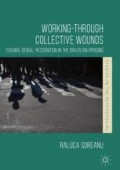Abstract
The chapter looks at the making of an important symbol of the 2013 Brazilian uprising. In July 2013, Amarildo de Souza, a bricklayer in the community of Rocinha, a favela in Rio de Janeiro, disappeared without a trace during a police investigation. This disappearance assembled into a political event of national and international resonance. While analysing the politics of memory around Amarildo’s figure, Soreanu theorises a new modality of State power: hyperpolitics, a politics of pure traumatic excess, consisting in the erasure of the demarcating line between life and death.
Access this chapter
Tax calculation will be finalised at checkout
Purchases are for personal use only
References
Agamben, G. (1997). Homo sacer. Le pouvoir souverain et la vie nue. Paris: Seuil.
Araújo, F. A. (2016). ‘Não tem corpo, não tem crime’: notas socioantropológicas sobre o ato de fazer desaparecer corpos. Horizontes Antropológicos, 46, 37–64.
Cardoso, I. (2001). Para uma crítica do presente. São Paulo: Editora 34.
Cocco, G. (2014b). Introdução – A dança dos vagalumes. In B. Cava & G. Cocco (Eds.), Amanhã vai ser maior: o levante da multidão no ano que não terminou (pp. 11–34). São Paulo: Annablume.
Deleuze, G., & Guattari, F. (1987). A thousand plateaus (trans: Massumi, B.). Minneapolis: University of Minnesota Press.
Fanon, F. (1986). Black skin, white masks (trans: Markmann, C. L.). London: Pluto.
Foucault, M. (1997). Il faut défendre la société: Cours au Collège de France, 1975–1976. Paris: Seuil.
Frosh, S. (2013b). Psychoanalysis, colonialism, racism. Journal of Theoretical and Philosophical Psychology, 33, 141–154.
Frosh, S., & Baraitser, L. (2003). Thinking, recognition and otherness. The Psychoanalytic Review, 90(6), 771–789.
Hook, D. (2008). Fantasmatic transactions: On the persistence of apartheid ideology. Subjectivity, 24, 275–297.
Mbembe, A. (2003). Necropolitics. Public Culture, 15, 11–40.
Moritz Schwarcz, L. (1993). O espetáculo das raças: cientistas, instituições e questão racial no Brasil, 1870–1930. São Paulo: Companhia das Letras.
Padrós, E. S. (2007). A política de desaparecimento como modalidade repressiva das ditaduras de segurança nacional. Tempos históricos, 10(1), 105–129.
Soreanu, R. (2015a). O que pode um rosto? O que pode um braço? O levante brasileiro e a nova estética do protesto. Lugar Comum, 43, 203–225.
Soreanu, R. (2015b). What can a face do? What can an arm do? In G. Cocco & B. Szaniecki (Eds.), Creative capitalism, multitudinous creativities: Radicalities and alterities (pp. 107–126). London: Lexington.
Žižek, S. (1997). The plague of fantasies. London/New York: Routledge.
Author information
Authors and Affiliations
Copyright information
© 2018 The Author(s)
About this chapter
Cite this chapter
Soreanu, R. (2018). Faces. In: Working-through Collective Wounds. Studies in the Psychosocial. Palgrave Macmillan, London. https://doi.org/10.1057/978-1-137-58523-3_8
Download citation
DOI: https://doi.org/10.1057/978-1-137-58523-3_8
Published:
Publisher Name: Palgrave Macmillan, London
Print ISBN: 978-1-137-58522-6
Online ISBN: 978-1-137-58523-3
eBook Packages: Behavioral Science and PsychologyBehavioral Science and Psychology (R0)

